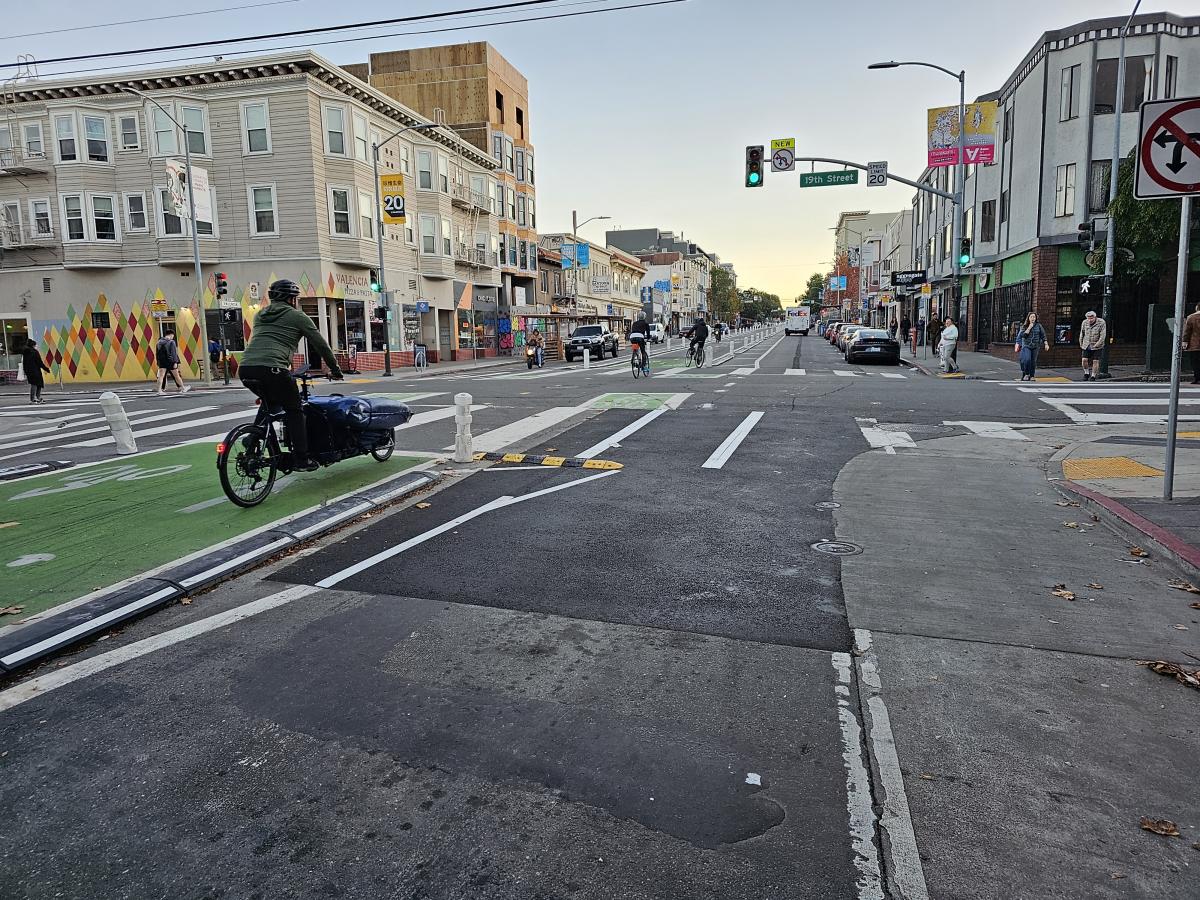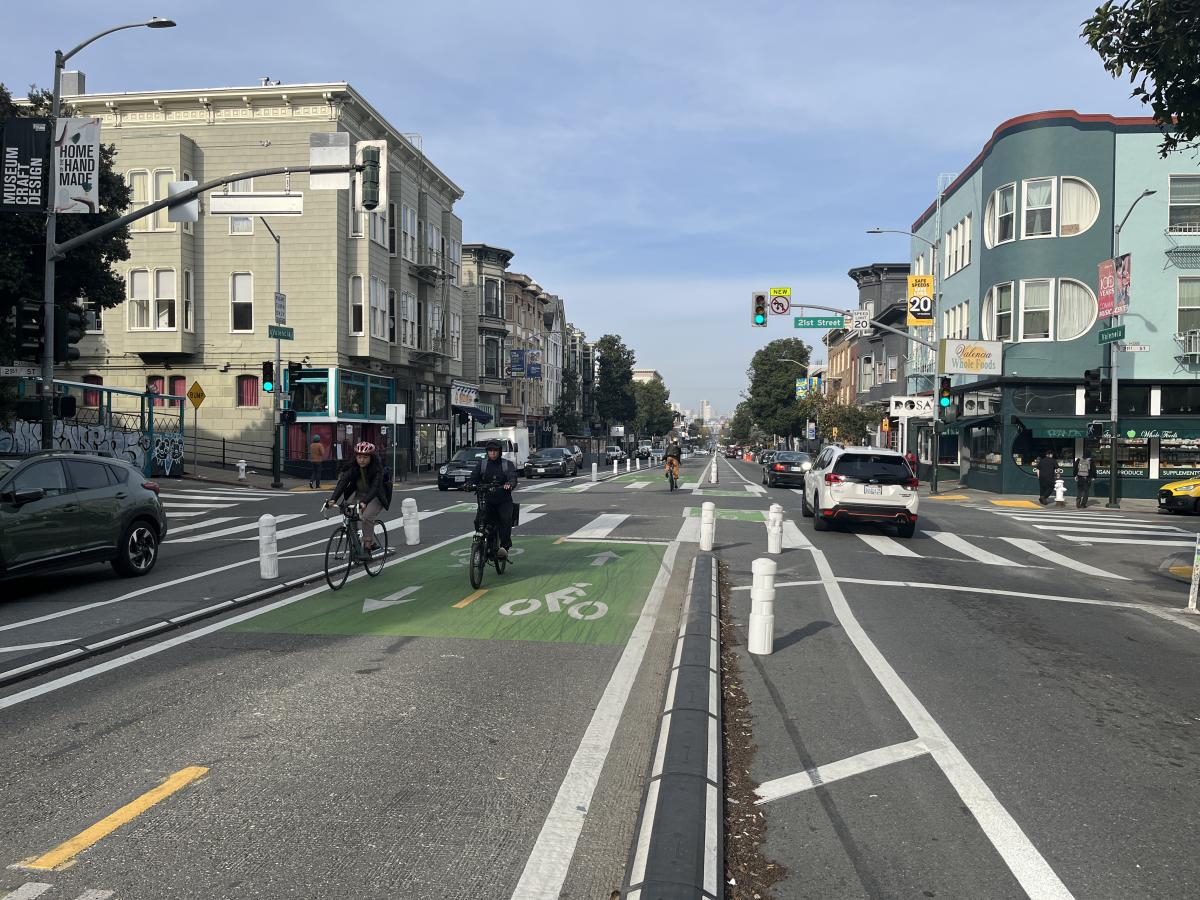By Project Staff

People biking on Valencia Street use the center-running bikeway installed as a pilot last August.
Last August, we installed a pilot bikeway project on Valencia Street with a protected bike lane running down the center of the street between 15th and 23rd streets. This center-running design isn’t standard, nor was it the first design we proposed. We chose this unconventional solution to meet two major needs of the corridor: (1) creating a protected bike lane while (2) preserving more loading, parking and the Shared Spaces parklets that businesses rely on.
Our project team has been hard at work crunching the numbers to see how the pilot has been performing. Given the strong interest in the project, we’re sharing an early snapshot of data collected three months into the pilot. However, it typically takes about six months for people to adapt to a new roadway design.
Drivers, bicyclists and pedestrians need time to learn and navigate the new right-of-way and adjust their travel patterns. Smaller data pools also run the risk of not being representative of the bigger picture. So, it’s useful to know that the next rounds of data may be more telling than the first.
Compared to the same month in 2022, we’re seeing that the center-running pilot has been very effective in minimizing the previous dangerous conditions and concerns. Vehicle behaviors are more predictable and there are fewer conflicts between bikes and cars. There are fewer cars blocking the bike lane forcing bicyclists into the road and fewer dooring incidents. Many cyclists have reported a more comfortable experience and a less stressful ride.
The center-running lane also better accommodates the diverse loading needs of the corridor and has reduced unsafe and illegal vehicle loading behaviors. Before the pilot, much of the loading happened in the bike lane and the travel lane. Of the loading activities observed, double-parking instances decreased by 77%, with most loading now being done at the curb. Double-parking is still the most common on the densest blocks and during the evening hours as dinner delivery services increase.
In these first three months, we observed a 26% decrease in vehicle volumes but an increase in loading activity such as ride-hailing and food deliveries. We estimate that:
-
Total loading events have increased by 27%
-
Passenger drop-offs by ride-hail services and taxis have increased by 126% on Fridays
-
Passenger drop-offs by private passenger vehicles and pick-up trucks have increased by 13% on all days observed
-
Goods pick-up (potentially food delivery) has increased by 43%.
We can’t be certain without more data, but this could mean that much of the drop in vehicle volumes was from through traffic.
We did not find any significant changes to daily bicycle or pedestrian volumes (+3% bicycle, -5% pedestrian).
At the same time, there are new concerns about this design, both because it’s unique and because of new limitations drivers are adjusting to. Left-turn restrictions were implemented to protect bicyclists crossing the intersection. There were 11 collisions in the area of the pilot during the three-month study period. Half of the collisions that occurred were caused by illegal left or U-turns. We are taking immediate steps to address this, including installing additional turn restriction signage and coordinating with SFPD for additional enforcement.
The full three-month evaluation will be presented at the February 20 SFMTA Board of Directors meeting.
Next Steps
The center-running bikeway is a pilot, and pilots are meant to be evaluated and adjusted, or even redone if they’re not working. But we cannot go back to unprotected bike lanes. They simply were not safe. While we're evaluating the pilot, we're also responding to immediate concerns and working on both short- and long-term solutions.
This winter: We’ve been working quickly to address feedback we’ve heard about parking being difficult or confusing. In November we adjusted the loading zone hours to turn into general parking in the afternoon to support businesses.
Some businesses have told us it can be confusing for customers to know where they can park, so in the coming weeks we’ll be trying out the more familiar single-space meters on a couple blocks. If people like them, we'll go back to single-space meters on the rest of the corridor. These meters will clearly show when and where it’s okay to park.
Multi-space meters are still a good solution in most neighborhoods, but on this bicycle-heavy corridor the single-space meters have the added benefit of providing bike parking. The meters will also be accompanied by new parking signs that will help make it more clear what kind of activities are okay at different times of day.
This year: While we’re evaluating the pilot, we’re revisiting the feasibility of a side-running protected bikeway, similar to what we had originally proposed. But it can’t happen overnight. Before we finalize any new proposal, we’re going out to talk with community members about the benefits and tradeoffs of a side-running design.

We’re working closely with community members to choose the best design for the corridor.
Every block of Valencia is unique and requires a tailored approach to maximize parking and loading and ensure that community feedback is incorporated. We’re also having discussions with other city agencies to ensure the design works for emergency vehicle operations.
Any side-running design would remove more parking and loading than the current center-running design. Daylighting would need to be installed on either side of driveways. For businesses that operate a parklet and want to keep it at the curb, it would mean losing more parking. Two to four additional spaces per parklet would be lost because the bike lane has to go around the parklet. An option that would help preserve parking would be to convert parklets to a “floating” design with a bikeway running between them and the sidewalk. This design requires less parking loss for each parklet.
We’re coordinating closely with merchants and other stakeholders so that the final design is one that allows businesses to thrive while meeting our goal of making Valencia a safer place to walk, ride and drive.
We know the community is eager for us to make changes to Valencia. We’re working as fast as we can to continue exploring a side-running bikeway option, while making sure that we thoughtfully and thoroughly address the needs of this space-constrained and active corridor.
Beyond this year: We’re also looking at other long-term design options such as making Valencia one-way or converting it into a pedestrian promenade. However, these designs would require years of study, and we would need to find funding.
Published February 16, 2024 at 05:56AM
https://ift.tt/mqWIx1S
Comments
Post a Comment